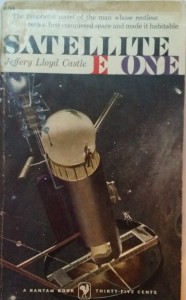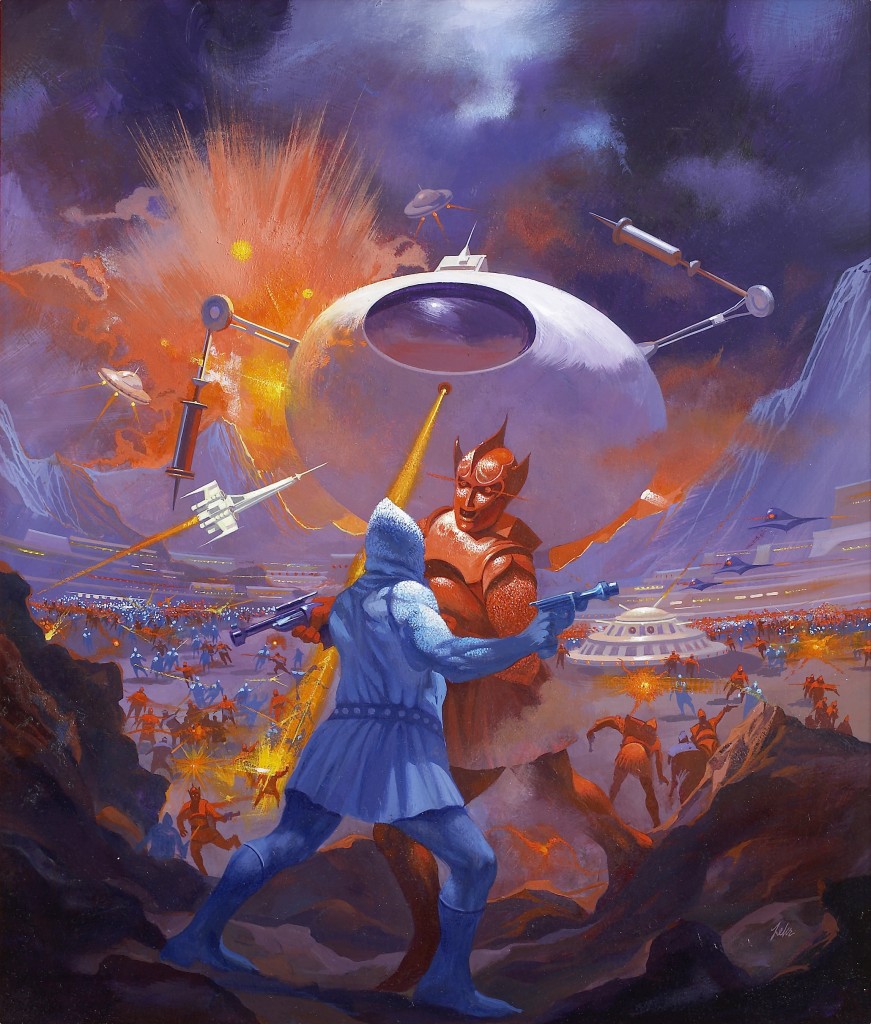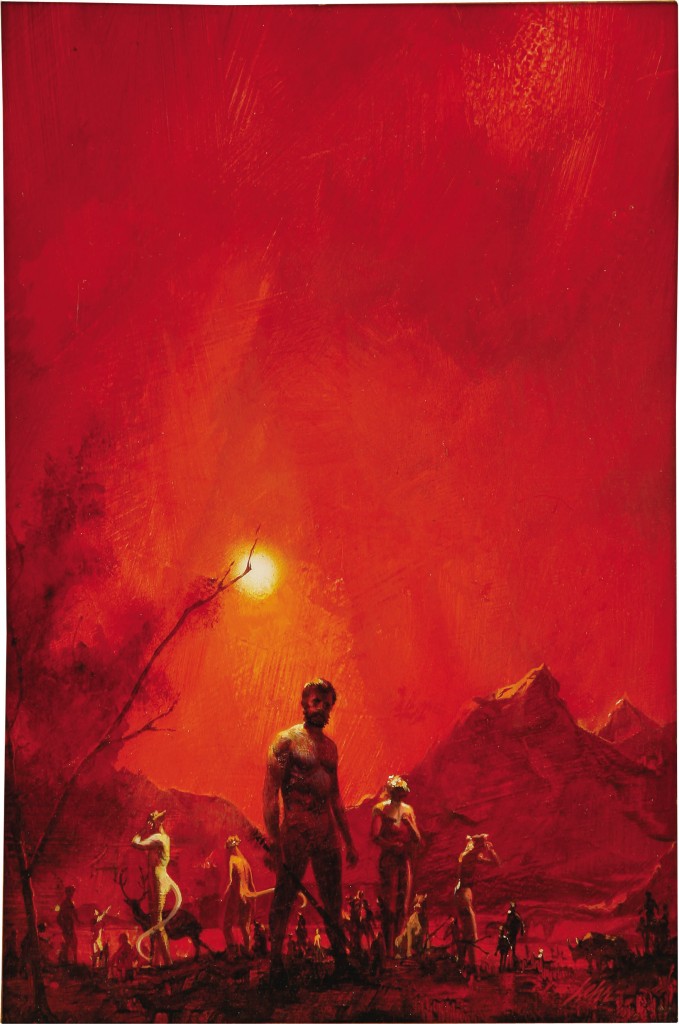Paul Lehr is not exactly a houshold name. Even among fans of science fiction and fantasy art his is usually not a name that comes to the top of mind when one is talking or thinking about science fiction artists.
 But if you did read science fiction in the late sixties and early seventies, and you read a lot of paperbacks then you are likely familiar with his images.
But if you did read science fiction in the late sixties and early seventies, and you read a lot of paperbacks then you are likely familiar with his images.
Lehr studied illustration at the prestigious Pratt Institute, where he worked under Stanley Meltzoff, an early influence on his art. His first sf cover – for the American edition of Jeffery Lloyd Castle’s Satellite E One (1954) – is a realistic depiction of the construction of an unusually-shaped Space Station, and similar images of spacecraft, rendered mostly in shades of grey, are seen in other early covers for James Blish’s Galactic Cluster (coll 1959), John Wyndham’s The Outward Urge (coll 1959 as by Wyndham and Lucas Parkes), and the May 1959 issue of Satellite Science Fiction. However, his 1960 cover for Brian W Aldiss’s Starship from the 1956 issue of Science Fantasy #17 and his cover for Robert Sheckley’s Journey Beyond Tomorrow (October-November 1962 Fantasy and Science Fiction) show Lehr moving toward the less representational style that would later be his trademark.
 His first noteworthy work in this vein, perhaps, was his cover for James Gunn’s Future Imperfect (coll 1964), depicting a Medusa-like woman and a human-headed spider amidst odd designs within a rectangle that is partially shattered. His covers for a 1967 edition of H G Wells’s The Food of the Gods and How It Came to Earth (1904) and Sheckley’s Dimension of Miracles (1968) display what became one of his trademarks, strange egg-shaped objects, here broken to respectively reveal an enormous eye and an array of planets and stars. While his people often seem small and insignificant in contrast to the large structures dominating his covers, Lehr was capable of foregrounding the human figure, as shown by his 1973 cover for Frank Herbert’s The Godmakers, showing a huge, skyward-looking statue being worshipped by a shrouded supplicant. Lehr could also make effective use of bright pastel colours, which tended to make his covers stand out amidst others dominated by darker hues.
His first noteworthy work in this vein, perhaps, was his cover for James Gunn’s Future Imperfect (coll 1964), depicting a Medusa-like woman and a human-headed spider amidst odd designs within a rectangle that is partially shattered. His covers for a 1967 edition of H G Wells’s The Food of the Gods and How It Came to Earth (1904) and Sheckley’s Dimension of Miracles (1968) display what became one of his trademarks, strange egg-shaped objects, here broken to respectively reveal an enormous eye and an array of planets and stars. While his people often seem small and insignificant in contrast to the large structures dominating his covers, Lehr was capable of foregrounding the human figure, as shown by his 1973 cover for Frank Herbert’s The Godmakers, showing a huge, skyward-looking statue being worshipped by a shrouded supplicant. Lehr could also make effective use of bright pastel colours, which tended to make his covers stand out amidst others dominated by darker hues.
 As artist Jane Frank has observed, Lehr “dominated science fiction covers in the mid-1960s into the 1970s”, and while his works were not as extravagantly surreal as those of an artist he is sometimes compared to, Richard M Powers, those two artists did contribute significantly to the distinctively imaginative style of sf art during that era, which for some represents the peak of the form’s long history. As American publishers came to prefer more realistic art in the 1980s, Lehr focused instead on covers for the sf magazines Analog, Omni, Tomorrow: Speculative Fiction, and Weird Tales as well as covers for foreign publishers. Lehr also worked outside the genre for magazines like Business Week, Fortune, Life, Playboy, The Reader’s Digest, and Time.
As artist Jane Frank has observed, Lehr “dominated science fiction covers in the mid-1960s into the 1970s”, and while his works were not as extravagantly surreal as those of an artist he is sometimes compared to, Richard M Powers, those two artists did contribute significantly to the distinctively imaginative style of sf art during that era, which for some represents the peak of the form’s long history. As American publishers came to prefer more realistic art in the 1980s, Lehr focused instead on covers for the sf magazines Analog, Omni, Tomorrow: Speculative Fiction, and Weird Tales as well as covers for foreign publishers. Lehr also worked outside the genre for magazines like Business Week, Fortune, Life, Playboy, The Reader’s Digest, and Time.
After his retirement from illustration Lehr retreated to his home in rural Pensylvania where he turned to sculpture. Lehr created fantastical works carved from wood or fashioned out of metal.
Lehr’s daughter, Diana is an artist herself as well as a filmmaker. She is currently putting together a feature documentary about her father and his art called The Visionary World of Paul Lehr.






















Paul Lehr was the artist for sci-fi cover art in the 60s-70s. Distinctive and beautiful style. Looks like the documentary film project has fallen thru. An art book would be wonderful, but it appears that is also not on the horizon. Perhaps the Lehr family has lost publication rights to the artwork? What a wonderful book that would be. Plenty of artwork can be seen on the web, but certainly not as satisfying as a large hard copy collection would be. Oh well,
The film has not fallen through. It is still in the works!
About 35-40 years ago I had a Paul Lehr original that he loaned me for some reason I’ve forgotten; it was for “The Power of Blackness” by Jack Williamson, but I had to return it. It was an amazing piece.
Great covers! I immediately recognized that first one from Starship Troopers, the edition I read when I was a kid.